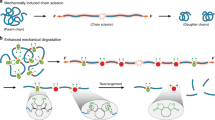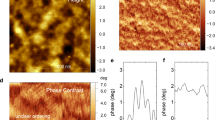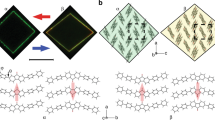Abstract
Mechanoresponsive polymers hold great technological potential in drug delivery, ‘smart’ optical systems and microelectromechanical systems. However, hysteresis and fatigue (associated with large-scale polymer chain rearrangement) are often problematic. Here, we describe a polyarylamide film that contains s-dibenzocyclooctadiene (DBCOD), which can generate unconventional and completely reversible thermal contraction under low-energy stimulation. The films exhibit a giant negative thermal expansion coefficient of approximately −1,200 ppm K−1 at ambient or near-ambient temperatures, much higher than any known negative-thermal-expansion materials under similar operating conditions. Mechanical characterization, calorimetry, spectroscopic analysis and density-functional theory calculations all point to the conformational change of the DBCOD moiety, from the thermodynamic global energy minimum (twist-boat) to a local minimum (chair), as the origin of this abnormal thermal shrinkage. This newly identified, low-energy-driven, thermally agile molecular subunit opens a new pathway to creating near-infrared-based macromolecular switches and motors, and for ambient thermal energy storage and conversion.
This is a preview of subscription content, access via your institution
Access options
Subscribe to this journal
Receive 12 print issues and online access
$259.00 per year
only $21.58 per issue
Buy this article
- Purchase on Springer Link
- Instant access to full article PDF
Prices may be subject to local taxes which are calculated during checkout




Similar content being viewed by others
Change history
22 April 2014
In the version of this Article previously published, some incorrect data were included in Fig. 1e. The initial data were inadvertently repeated as the data for 20,000 cycles, and the total number of cycles was stated as 50,000 when it should have been 43,000. An error corresponding to the latter was also made in the first full sentence on page 1037. Figure 1e should have appeared as shown above. These errors have been corrected in the online versions of the Article.
22 April 2014
Nature Chemistry 5, 1035–1041 (2013); Published online 20 October 2013; corrected after print 22 April 2014. In the version of this Article previously published, some incorrect data were included in Fig. 1e. The initial data were inadvertently repeated as the data for 20,000 cycles, and the total number of cycles was stated as 50,000 when it should have been 43,000.
References
Xie, T. Recent advances in polymer shape memory. Polymer 52, 4985–5000 (2011).
Seiffert, S. & Sprakel, J. Physical chemistry of supramolecular polymer networks. Chem. Soc. Rev. 41, 909–930 (2012).
Lendlein, A. & Shastri, V. P. Stimuli-sensitive polymers. Adv. Mater. 22, 3344–3347 (2010).
Liu, F. & Urban, M. W. Recent advances and challenges in designing stimuli-responsive polymers. Prog. Polym. Sci. 35, 3–23 (2010).
Thomsen, D. L. et al. Liquid crystal elastomers with mechanical properties of a muscle. Macromolecules 34, 5868–5875 (2001).
Yang, L. Q., Setyowati, K., Li, A., Gong, S. Q. & Chen, J. Reversible infrared actuation of carbon nanotube–liquid crystalline elastomer nanocomposites. Adv. Mater. 20, 2271–2275 (2008).
Zhang, X. B. et al. Optically- and thermally-responsive programmable materials based on carbon nanotube–hydrogel polymer composites. Nano Lett. 11, 3239–3244 (2011).
Schild, H. G. Poly(N-isopropylacrylamide)—experiment, theory and application. Prog. Polym. Sci. 17, 163–249 (1992).
Liu, Y. Y., Han, C. M., Tan, H. F. & Du, X. W. Thermal, mechanical and shape memory properties of shape memory epoxy resin. Mater. Sci. Eng. A 527, 2510–2514 (2010).
Li, J. et al. A versatile approach to achieve quintuple-shape memory effect by semi-interpenetrating polymer networks containing broadened glass transition and crystalline segments. J. Mater. Chem. 21, 12213–12217 (2011).
Kim, B. K., Lee, S. Y. & Xu, M. Polyurethanes having shape memory effects. Polymer 37, 5781–5793 (1996).
Yu, Y. L., Nakano, M. & Ikeda, T. Directed bending of a polymer film by light—miniaturizing a simple photomechanical system could expand its range of applications. Nature 425, 145 (2003).
Yoshino, T. et al. Three-dimensional photomobility of crosslinked azobenzene liquid-crystalline polymer fibers. Adv. Mater. 22, 1361–1363 (2010).
Tabiryan, N., Serak, S., Dai, X. M. & Bunning, T. Polymer film with optically controlled form and actuation. Opt. Express 13, 7442–7448 (2005).
Finkelmann, H., Nishikawa, E., Pereira, G. G. & Warner, M. A new opto-mechanical effect in solids. Phys. Rev. Lett. 87, 015501 (2001).
Kamarajan, P. & Chao, C. C-K. UV-induced apoptosis in resistant HeLa cells. Biosci. Rep. 20, 99–108 (2000).
Ugur, G., Chang, J., Xiang, S., Lin, L. & Lu, J. A near-infrared mechano responsive polymer system. Adv. Mater. 24, 2685–2690 (2012).
Greve, B. K. et al. Pronounced negative thermal expansion from a simple structure: cubic ScF3 . J. Am. Chem. Soc. 132, 15496–15498 (2010).
Barrera, G. D., Bruno, J. A. O., Barron, T. H. K. & Allan, N. L. Negative thermal expansion. J. Phys.: Condens. Matter 17, 217–252 (2005).
Miller, W., Smith, C. W., Mackenzie, D. S. & Evans, K. E. Negative thermal expansion: a review. J. Mater. Sci. 44, 5441–5451 (2009).
Lind, C. Two decades of negative thermal expansion research: where do we stand? Materials 5, 1125–1154 (2012).
Sleight, A. W. Isotropic negative thermal expansion. Annu. Rev. Mater. Sci. 28, 29–43 (1998).
Alkorta, I. & Elguero, J. Conformational analysis of dibenzo[a,e]cyclooctadiene and three related heterocyclic compounds. Struct. Chem. 21, 885–891 (2010).
Domiano, P. et al. The molecular structure of 6, 8, 6 and related systems. J. Chem. Soc. Perkin Trans. 2 1992, 1609–1620 (1992).
Hamza, A. Gas-phase conformations and exciton couplings in 5,6,11,12-tetrahydrodibenzo[a,e]cyclooctene. Struct. Chem. 21, 787–793 (2010).
Jimeno, M. L. et al. Conformation of 5,6,11,12-tetrahydrodibenzo[a,e]cyclooctene: an experimental and theoretical NMR study. New. J. Chem. 22, 1079–1083 (1998).
Walker, K. A. et al. Cross-linking chemistry for high-performance polymer networks. Polymer 35, 5012–5017 (1994).
Pingel, E. et al. Thermally crosslinkable thermoplastic PET–co-XTA copolyesters. Polymer 40, 53–64 (1999).
Mary, T. A., Evans, J. S. O., Vogt, T. & Sleight, A. W. Negative thermal expansion from 0.3 to 1050 Kelvin in ZrW2O8 . Science 272, 90–92 (1996).
Goodwin, A. L. et al. Colossal positive and negative thermal expansion in the framework material Ag3[Co(CN)6]. Science 319, 794–797 (2008).
Yang, C., Wang, X. P. & Omary, M. A. Crystallographic observation of dynamic gas adsorption sites and thermal expansion in a breathable fluorous metal–organic framework. Angew. Chem. Int. Ed. 48, 2500–2505 (2009).
Das, D., Jacobs, T. & Barbour, L. J. Exceptionally large positive and negative anisotropic thermal expansion of an organic crystalline material. Nature Mater. 9, 36–39 (2010).
Anet, F. A. L. Dynamics of eight-membered rings in the cyclooctane class. Top. Curr. Chem. 45, 169–220 (1974).
Hendrickson, J. B. Molecular geometry. I. Machine computation of the common rings. J. Am. Chem. Soc. 83, 4537–4547 (1961).
Grima, J. N., Attard, D. & Gatt, R. Unusual thermoelastic properties of methanol monohydrate. Science 331, 687–688 (2011).
Contreras-Garcia, J. et al. NCIPLOT: a program for plotting noncovalent interaction regions. J. Chem. Theory Comput. 7, 625–632 (2011).
Johnson, E. R. et al. Revealing noncovalent interactions. J. Am. Chem. Soc. 132, 6498–6506 (2010).
Frisch, M. J. et al. GAUSSIAN 09, Revision C.01 (Gaussian, 2010).
Lee, C. T., Yang, W. T. & Parr, R. G. Development of the Colle–Salvetti correlation-energy formula into a functional of the electron-density. Phys. Rev. B 37, 785–789 (1988).
Becke, A. D. Density-functional thermochemistry. III. The role of exact exchange. J. Chem. Phys. 98, 5648–5652 (1993).
Torres, E. & DiLabio, G. A. A (nearly) universally applicable method for modeling noncovalent interactions using B3LYP. J. Phys. Chem. Lett. 3, 1738–1744 (2012).
Acknowledgements
The authors thank D.C. Martin for providing XTA (prepared by K. Walker, L. Markoski and G. Spilman in the laboratory of J. Moore), and C.Y.C. Lee for technical discussions. The authors acknowledge financial support from DARPA (grant no. N66001-09-1-2088), CITRIS (grant no. 73-2010), UC Merced start-up and the National Science and Technology Key Project of China (2012AA020204).
Author information
Authors and Affiliations
Contributions
J.Q.L. designed the polymer system, developed the NTE concept, designed the experiments and oversaw the project. C.V. conceived that cyclooctane is an unconstrained unit and designed the mechanical tests. The synthesis strategy was developed by C.C.W., X.S. and J.Q.L. and was performed and refined by X.S. Films were prepared by X.S. Mechanical characterization apparatus was designed by C.V. and performed by X.S., mainly with help from C.V. Data were analysed by J.Q.L. with help from E.R.J. and X.S. Quantum chemical calculations were carried out by E.R.J. The manuscript was prepared by J.Q.L. with help from E.R.J., C.V., C.C.W. and X.S.
Corresponding author
Ethics declarations
Competing interests
The authors declare no competing financial interests.
Supplementary information
Supplementary information
Supplementary information (PDF 2241 kb)
Supplementary Movie 1
Supplementary Movie 1 (MOV 2065 kb)
Rights and permissions
About this article
Cite this article
Shen, X., Viney, C., Johnson, E. et al. Large negative thermal expansion of a polymer driven by a submolecular conformational change. Nature Chem 5, 1035–1041 (2013). https://doi.org/10.1038/nchem.1780
Received:
Accepted:
Published:
Issue Date:
DOI: https://doi.org/10.1038/nchem.1780
This article is cited by
-
The viscosity-radius relationship for concentrated polymer solutions
Scientific Reports (2019)
-
Giant anisotropic thermal expansion actuated by thermodynamically assisted reorientation of imidazoliums in a single crystal
Nature Communications (2019)
-
Theoretical studies of conformational analysis and intramolecular dynamic phenomena
Structural Chemistry (2019)
-
An electromagnetic anglerfish-shaped millirobot with wireless power generation
Biomedical Microdevices (2019)
-
Imaging the transient heat generation of individual nanostructures with a mechanoresponsive polymer
Nature Communications (2017)



